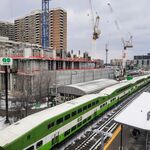innsertnamehere
Superstar
Ontario Newsroom
Ontario will also upload 174 in Ottawa.
Any bets now on whether the Linc/RHVP and E.C. ROW are up next? The province is already paying for a new interchange on the EC ROW..
I guess they don't want people to note that this will be a 're-upload' since it used to be Hwy 17.Ontario Newsroom
news.ontario.ca
Ontario will also upload 174 in Ottawa.
Any bets now on whether the Linc/RHVP and E.C. ROW are up next? The province is already paying for a new interchange on the EC ROW..
The big reason for the upload is because many of the bridges are reaching EOL and need replacing, something that is very expensive and Ottawa doesn't have the money for. This is basically a gift for the city similar to uploading the Gardiner.I guess they don't want people to note that this will be a 're-upload' since it used to be Hwy 17.
I'm a wee bit surprised of the timing. I would have thought this - and maybe the two you cite, would be announced during a municipal election or held for the next provincial ones.
The big reason for the upload is because many of the bridges are reaching EOL and need replacing, something that is very expensive and Ottawa doesn't have the money for. This is basically a gift for the city similar to uploading the Gardiner.
Unless E.C Row and RHVP have similar issues I don't see them being uploaded.
Ontario Advances Construction to Expand Garden City SkywayProvince building two, four-lane bridges to help fight gridlock and move people and goods across the Greater Golden HorseshoeApril 05, 2024 Ministry of Transportation | ||
| ST. CATHARINES – The Ontario government has issued a Request for Proposals to advance the expansion of the Queen Elizabeth Way (QEW) Garden City Skyway, marking another milestone in the province’s plan to reduce gridlock, connect more people to jobs and provide a crucial link between Ontario’s international border crossings and the Greater Golden Horseshoe. “With Ontario’s population growing at a historic rate, we need to ensure our transportation infrastructure keeps pace,” said Prabmeet Sarkaria, Minister of Transportation. “The new and expanded Garden City Skyway will be a game-changer, meaning less congestion and faster travel for the people of St. Catharines and Niagara Region.” The Skyway expansion includes construction of a new four-lane, 2.2-kilometre bridge across the Welland Canal, as well as the rehabilitation and full deck replacement of the current bridge. Once complete, each bridge will have four lanes with the new bridge carrying Toronto-bound traffic and the upgraded existing bridge carrying Niagara-bound traffic. “The Request for Proposals (RFP) is an important step on the path to expanding the Garden City Skyway. With the projected increases in population and jobs throughout the Greater Golden Horseshoe in the coming years, this expansion will allow people and goods to travel more freely through Niagara,” said Mat Siscoe, Mayor of St. Catharines. “The City of St. Catharines is looking forward to the completion of this project and the economic growth that will accompany it.” The expansion of the Garden City Skyway is among the more than 100 actions identified in the government’s Connecting the GGH: A Transportation Plan for the Greater Golden Horseshoe. | ||
Quick Facts
| ||
Quotes"Ontario’s highway infrastructure is critical to the growth and economic prosperity of our province. As part of our plan to build Ontario, our government is continuing to invest in essential infrastructure like the Garden City Skyway to make it easier for people to travel, while supporting businesses that rely on Ontario’s highways and bridges to deliver goods."- Kinga Surma Minister of Infrastructure "Our government is delivering on its plan to build by investing in critical infrastructure like the Garden City Skyway. Drivers know that under the leadership of Premier Ford, our government is getting it done by building better roads to reduce gridlock and get people moving. By strengthening the link between the Greater Golden Horseshoe and U.S. border crossings, we’re supporting our province’s supply chain, strengthening our economy and building a better Ontario." - Sam Oosterhoff MPP for Niagara West |
Likely it is the heaviest ever since it opened back in 1997.Wonder if that's the most congested the 407 has ever been from volume alone.
JuSt AlLoW tRuCkS tO rIdE oN 407 FoR fReE!!!View attachment 554590
407 traffic today...
The QEW is the only highway where people seem to generally go less than the limit in my experience. (minus the HOV usually)Coming home from the us today, all highways in, around and near Buffalo have signs up warning travelers to expect delays on April 8
Heading to Detroit on Sat, had a look at the roadwork west of Hwy 8 for the centre bridge as well the new roadwork. Photos will follow this coming week.
I see they finally put in the poor use HOV lane for all the new sections in Cambridge and what a waste.
Saw an unmarked OPP car pull over a single driver in the HOV on the QEW with tons of single drivers passing it. Unless you were not willing to do 130+ in that HOV lane, you were not welcome in it as cars were flipping around them illegally doing lane changes where they were not to do it.
They really need to widen the 403 to 4 lanes from the QEW as it is a pain to crawl up it until you get to the 407/403 split.




